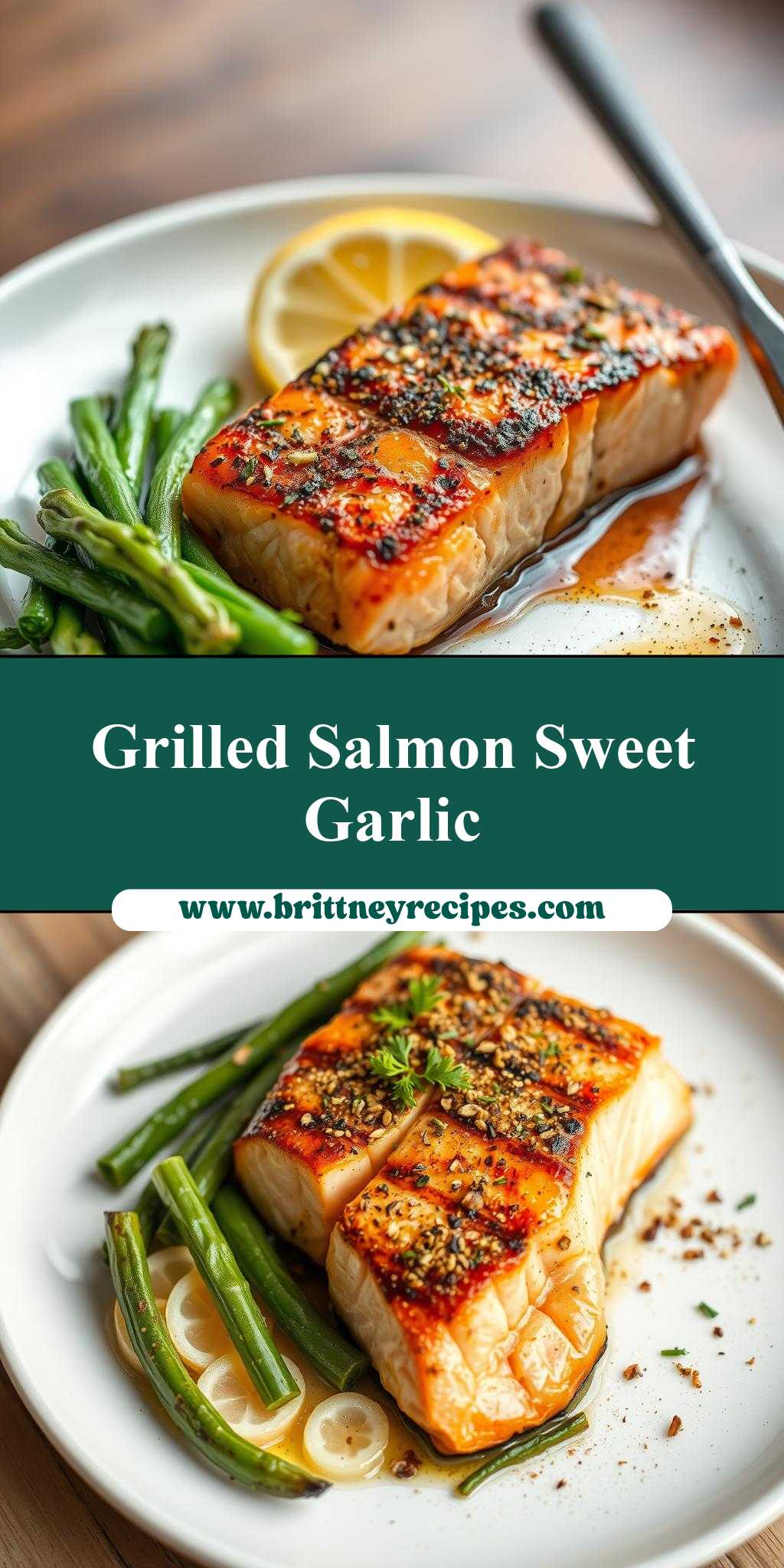What’s the secret to making grilled salmon truly unforgettable? It all comes down to the seasoning. This easy homemade blend takes weeknight dinner to the next level with smoky paprika and fresh lemon. Try this family favorite recipe soon and save this idea for your next quick dinner inspiration.
grilled salmon with the best salmon seasoning recipe
Introduction
Imagine a dish that combines the succulent flavor of grilled salmon with a burst of aromatic spices, all achieved with everyday ingredients and minimal effort. This recipe for grilled salmon with the best salmon seasoning is a game-changer for anyone looking to elevate their seafood game without sacrificing ease or flavor. Whether you’re a seasoned chef or a beginner in the kitchen, this recipe promises to deliver an impressive dining experience with its perfect balance of tanginess, sweetness, and smokiness.
Why This Works
- Flavor balance and ingredient accessibility: The combination of lemon, garlic, and herbs creates a symphony of flavors that complement the salmon perfectly, and all the ingredients are easily found in most supermarkets.
- Ease of preparation: The salmon seasoning is a breeze to mix together, and the grilling process is straightforward, making this a weeknight dinner option or a special occasion dish with equal ease.
- Impressive results with minimal effort: The end result is a beautifully grilled piece of salmon with a crispy exterior and a moist interior, sure to impress any dinner guest with its simplicity and elegance.
Key Ingredients
The key to this recipe lies in its simple yet effective ingredients. You’ll need fresh salmon fillets, olive oil, freshly squeezed lemon juice, minced garlic, chopped fresh dill, salt, and pepper. For the salmon seasoning, a mix of paprika, dried thyme, and a pinch of cayenne pepper (optional, for some heat) does the trick. Practical substitutions include using dried dill if fresh isn’t available, or swapping out the cayenne pepper for red pepper flakes. The beauty of this recipe is its flexibility and the ability to adjust the seasoning to your taste preferences.
Instructions
- Step 1: Begin by preheating your grill to medium-high heat. While the grill is warming up, prepare the salmon seasoning by mixing together the paprika, thyme, salt, pepper, and cayenne pepper (if using) in a small bowl.
- Step 2: Prepare the salmon fillets by rinsing them under cold water, patting them dry with paper towels, and then brushing both sides with olive oil. Sprinkle the salmon seasoning evenly over both sides of the fillets, making sure they’re well coated.
- Step 3: Place the salmon fillets on the grill, skin side down if they have skin. Close the grill lid and cook for about 4-6 minutes or until the skin is crispy and golden brown. Flip the salmon over and cook for an additional 4-6 minutes or until it reaches your desired level of doneness. The salmon is done when it flakes easily with a fork.
- Step 4: Once the salmon is cooked, remove it from the grill and let it rest for a minute or two. Serve hot, garnished with lemon wedges, chopped fresh dill, and your choice of sides, such as roasted vegetables or quinoa.
Handy Tips
- Make sure to not overcrowd the grill, as this can lower the temperature and affect the cooking time. Grill the salmon fillets one or two at a time, depending on their size and your grill’s capacity.
- Don’t press down on the salmon with your spatula while it’s grilling, as this can cause it to break apart and lose its juices.
- Keep an eye on the temperature and adjust the grill as needed to prevent burning. The ideal temperature for grilling salmon is between 400°F and 450°F.
Heat Control
Heat control is crucial when grilling salmon to achieve the perfect doneness without overcooking. The salmon should be grilled over medium-high heat to get a nice sear on the outside while keeping the inside moist and flaky. Use a meat thermometer to check for doneness; the internal temperature should reach 145°F for cooked salmon. Signs of doneness also include the salmon flaking easily with a fork and its color turning from translucent to opaque.
Crunch Factor
The crunch factor in this recipe comes from the crispy skin of the salmon, achieved by grilling it skin side down first. To enhance the crunch, make sure the skin is dry before grilling, and don’t move the salmon too much while it’s cooking. If your salmon fillets don’t have skin, you can still achieve a nice crust on the fish by not flipping it too often and letting it develop a nice sear on each side.
Pro Kitchen Tricks
- For an extra crispy skin, pat the salmon dry with paper towels before seasoning and grilling.
- Use a cast-iron or stainless steel grill pan on your stovetop if you don’t have an outdoor grill, heating it to high heat before adding the salmon.
- Let the salmon rest for a few minutes before serving to allow the juices to redistribute, making the fish more tender and flavorful.
Storage Tips
- Leftover grilled salmon can be stored in an airtight container in the refrigerator for up to 3 days. Reheat it gently in the oven or microwave until warmed through.
- For longer storage, consider freezing the cooked salmon. Place it in airtight freezer bags or containers, making sure to press out as much air as possible before sealing, and store in the freezer for up to 3 months. Thaw frozen salmon overnight in the refrigerator before reheating.
- When reheating, add a splash of water or lemon juice to keep the salmon moist and prevent drying out.
Gift Packaging Ideas
While grilled salmon is typically served fresh, the salmon seasoning mix can be a thoughtful gift for the seafood lovers in your life. Package the seasoning mix in small glass jars or decorative tins, and add a ribbon or gift tag with the recipe and cooking instructions. You could also include a few lemon wedges or a bunch of fresh dill in the gift basket for an extra-special touch.
Flavor Variations
- Different spices: Experiment with various spice blends like Cajun, Mediterranean, or Asian-inspired mixes to give your grilled salmon a unique flavor profile.
- Creative toppings: Top your grilled salmon with sauces like teriyaki, salsa, or pesto, or add some crunch with toasted nuts or seeds.
- Ingredient swaps: Try using different types of fish like trout or mahi-mahi, or substitute the lemon juice with lime or orange for a different citrus flavor.
Troubleshooting
- Texture problems: If the salmon turns out too dry, it may have been overcooked. Adjust the cooking time and temperature for the next batch. If it’s undercooked, return it to the grill for a few more minutes, checking frequently to avoid overcooking.
- Ingredient replacements: If you can’t find fresh dill, dried dill weed or even chopped fresh parsley can be used as a substitute. For the cayenne pepper, red pepper flakes or a pinch of hot sauce can add the desired heat.
- Over/undercooking signs: Keep an eye on the salmon’s color and texture. Cooked salmon will be opaque and flake easily, while undercooked salmon will be translucent and resist flaking. Overcooked salmon will be dry and tough.
FAQs
- Can I freeze it? Yes, cooked salmon can be frozen for up to 3 months. Cool it to room temperature, then place it in airtight freezer bags or containers, pressing out as much air as possible before sealing.
- Is it gluten-free? This recipe is naturally gluten-free, making it a great option for those with gluten intolerance or sensitivity. Just be sure to check the ingredients of any store-bought spices or seasonings used.
- Can I double the recipe? Absolutely, this recipe can be easily doubled or tripled to feed a larger crowd. Just adjust the cooking time slightly if grilling multiple fillets at once, to ensure they all cook evenly.
Conclusion
Grilled salmon with the best salmon seasoning recipe is a versatile and delicious dish that’s perfect for any occasion. With its combination of easy preparation, impressive presentation, and adaptable flavor profile, it’s sure to become a staple in your kitchen. Don’t be afraid to experiment with different seasonings and toppings to make the recipe your own, and enjoy the process of creating a truly memorable dining experience. Whether you’re cooking for one or for many, this recipe promises to deliver on flavor, texture, and satisfaction, making it a must-try for anyone who loves seafood.

